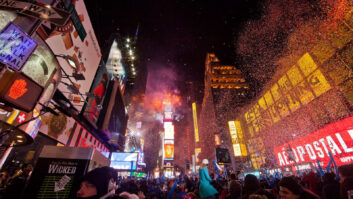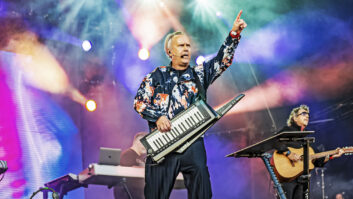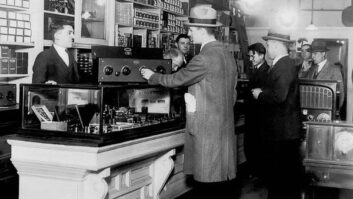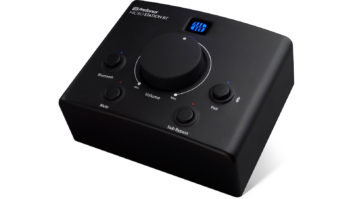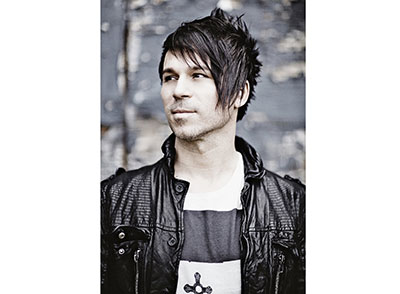
Brian Transeau, aka BT, has been a leading figure in EDM for the past several decades, but it would be a mistake to pigeonhole this multitalented artist. His tastes are eclectic, he has collaborated with a wide variety of artists (including Peter Gabriel and *NSYNC), and his credits as a film composer include The Fast and the Furious and Gone in 60 Seconds. He’s also provided music for a number of videogames.
BT recently completed work on a new album, an interesting work that infuses the layers of synths and beats he’s known for with an Asian aesthetic. It was released in June 2016.
What’s the title of this album?
The album is un-named. I’ve never done this before and I’m excited to hear what fans end up calling it. Like Prince’s Black Album or The White Album. It’s such a specific and unique body of compositions that it defied normal album-naming nomenclature.
What role did the country of Japan play in this work?
I wrote one piece watching a tropical storm roll in toward our hotel on the 80th floor in Tokyo. I actually filmed this as well. The concept was sonification of the feeling of travel. It’s all recorded, processed and mixed in remote locations while my wife and I were traveling.
Where did you record/mix these tracks?
In Poland; Prague; Kennebunkport, Maine; Orlando, Florida; Holland; Tokyo; Bora Bora; Rangiroa; L.A.; and D.C.
Did you engineer the project?
Yes. I mixed the whole album myself, over two-and-a-half hours of material.
What was your recording platform, desk, etc.?
I used the following DAWs in equal measure, in a specific order: FL Studio, Ableton Live 9 64-bit, Ableton Live 5 on Snow Leopard—Virtualized in parallels—Logic 9, Logic 6.43 in OS 9 with 24-bit Pro Tools, Cubase 7 and some Bitwig, as well. The special stuff was all done in CDP, Csound, SuperCollider, MAX and lots and lots of scripting in the terminal. Judicious field recordings, as well, including GoPro cameras diving on our honeymoon and lots of other crazy stuff. Again, I could write a paper about it.
For the track “Artifacture”: Did you have a plan when conceiving this work?
It’s a wild and long ride. There is the contrast between completely acoustic instrumental sections, spoken word and modern electronic rhythmic textures and rhythms. This is pretty characteristic of my body of work as a whole, but I had a lot of fun stretching the form and cross-pollinating these different and diverse modalities in a way I don’t often allow myself compositionally.
What instruments did you use in this piece?
It’s honestly way too many to list. There are lots of live instruments like the Strum Stick, Hammered Dulcimer, Bowed Guitars and small strung and plucked instruments I like to collect while traveling. I have a stereo mic/Ableton Live setup where I record stuff like this. There is some simple warp markering, next comes Melodyne—at times—then on to the OS 9 Logic/PT rig for time correction and basic sound design—reverse reverbs, EQ, compression.
The heavy-lifting sound-design stuff is mostly terminal [CDP] or Csound. I’ve written piles of Apple scripts to batch process things now. All the micro-rhythmic percussion treatments on this track were done with batch processing Break Tweaker stems in the OS X terminal using batch scripts I’ve made for CDP.
Sounds like a tuned sine wave and kick drum were playing the same pattern. If so, did you play both parts on one MIDI channel with the kick tuned to the same pitch on all keys?
It’s a low, mid and high stack for that kick. I like making kicks from scratch, so in this case a pitch-enveloped sine wave, a midrange plosive—FIR filtered about 400 samples in length—and a 30-sample hi-click are all used and glued together using a variety of compressors and limiters. Making drums from scratch is a very meditative and exciting hobby. Especially on the modular stuff. So much fun.
How does the inclusion of this kick drum/bass/snare section work with the other sections?
It’s a micro-movement I’d say and a reinstate of the main leitmotif but mirrored in the percussion and countermelodies.
Were you thinking of the Beatles “Revolution #9” when you decided to include the spoken section that eventually ends being detuned?
No, but I love the reference. It was just something that came to me and I asked Christian Burns and his whole family (mom, dad, niece, nephew, sisters) to say the same line. I kind of don’t want to talk about it too much because it’s a great twist in this composition you don’t see coming. It’s something missing from so much music currently. Surprise.
What instruments did you use in the round/canon that concludes this piece?
The final movement is 100 percent live modular improvisation.
For “Found In Translation”: Was the cello part written out first?
Yes. I wrote this down on staff paper and did a series of improvisations with three cellists. Then I actually did a considerable amount of the counterpoint using the harmonics in Melodyne. I’d never done this before and actually stumbled on a new technique that I’ve subsequently used in a couple new film scores.
For “7 Ω.m4a”: How would you define industrial music? Does this track qualify?
Industrial music, to me, uses found-sound objects usually associated with mechanical and other industrial types of machinery and the like. So although not necessarily industrial, I get where you’re coming from. The overall aesthetic is this idea of micro-movements as opposed to ternary form or other traditional compositional forms.
For “Five Hundred and Eighty Two,” there’s a touch of Zen here, and elsewhere in the album. Was this a conscious decision?
Yes, for sure!
For “Chromatophore”: There are water sounds, and it’s an atmospheric track. Is there an injection of the natural world at this point in the album?
Yes, absolutely. There were so many wonderful field recordings I’d made at this point I needed to find some good landing places for them. This was one.
What did you use for your bass sounds? Do you have a go-to bass?
This is a Yamaha DX5. Believe it or not, I made that patch from scratch; those reading that love FM synthesis know what a pain that is. That’s one of my favorite FM synths, but I’ve got a weak spot for Additive and FM physical synths.
Low frequency bass plus high-pitched kick—is this an orchestral combination that appeals to you?
That’s a great question, and yes! I love exploring different relationships these two entities can play in electronic composition. They are, after all, the cornerstones of electronic music. I love early drum and bass, how the kick plays an ostinato with a higher-pitched kick—almost the role of marching snare in orchestra—and the bass is subsonic—similar to contrabass and tuba in octaves. It’s a compelling way to make a unique motoring ostinato.
You have a great ear for the overtone series. What is the relationship between the part of this gift that is intuitive and the part that is thought out?
A bit of both, and thank you for the kind words. I’m obsessed with traditional orchestration and the overtone series. You have that so drilled into you in conservatory, the idea of reinforcing first, 8va, the 3rd (5th) harmonics because even in things that are atonal or dissonant it creates a familiarity or calm in the end user. It’s often overlooked in electronic music, but since I came up studying classical music and jazz, it’s something constantly at the forefront of my mind and therefore an integrated part of the compositional process for me.
Do you believe that soft synths and samplers have progressed to the point where hardware synths are obsolete?
Absolutely not, and they never will by virtue of what they are. One is a program and the other is a physical object. The haptic feedback you get from a physical object determines where you are led in a creative context. That’s the beauty of them. They literally guide you. Now don’t get me wrong, look at some of the amazing synthesizers made as software: Serum, Razor, I could go on and on, and I use them all. There are wonderful soft instruments. I’d say I’m not a fan of any subtractive emulation soft synths, like the more modern additive, spectral, granular, FFT stuff. And for physical instruments, I’ll keep things like my Fairlight CMI III, Prophet-5, Yamaha CS80 and probably 100 others until I’m dead and gone. They give me so much joy to restore those instruments to their former glory and use them in a modern context. I literally could not live without them.

